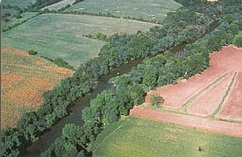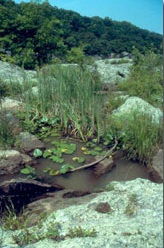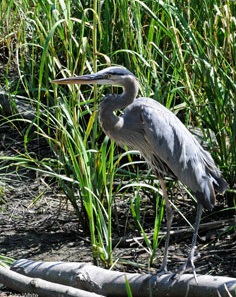The 100-foot Buffer
 A keystone of the Chesapeake Bay Critical Area Protection Program is the establishment, preservation, and maintenance of a 100-foot, naturally vegetated, forested buffer (the Buffer) landward from the Mean High Water Line of tidal waters or from the edge of tidal wetlands and tributary streams. The Buffer acts as a water quality filter for the removal or reduction of sediment, nutrients, and toxic substances found in runoff. The Buffer also minimizes the adverse impact of human activities on habitat within the Critical Area. No disturbance of the Buffer may be permitted by local jurisdictions unless an applicant can meet the strict provisions for a variance.
A keystone of the Chesapeake Bay Critical Area Protection Program is the establishment, preservation, and maintenance of a 100-foot, naturally vegetated, forested buffer (the Buffer) landward from the Mean High Water Line of tidal waters or from the edge of tidal wetlands and tributary streams. The Buffer acts as a water quality filter for the removal or reduction of sediment, nutrients, and toxic substances found in runoff. The Buffer also minimizes the adverse impact of human activities on habitat within the Critical Area. No disturbance of the Buffer may be permitted by local jurisdictions unless an applicant can meet the strict provisions for a variance.
Nontidal Wetlands

The minimum standards established by the State and adopted by the local jurisdictions for the conservation of nontidal wetlands in the Critical Area include:
- the establishment and maintenance of a vegetated buffer of 25 feet around areas identified as nontidal wetlands;
- new development must not substantially damage or change the character of nontidal wetlands;
- only new development that is intrinsically water-dependent, or of substantial economic benefit to the public, is allowed to disturb nontidal wetlands.
In the event of such development, measures must be taken to replace lost nontidal wetlands and to provide for water quality benefits and habitat protection equal to or greater than that provided by the original wetlands.
Threatened and endangered species
 All local jurisdictions within the Critical Area have adopted protection programs for all federally and State endangered species and their habitat. The limited distribution of the habitats of these endangered species make them highly susceptible to local land disturbances. The Criteria suggest a variety of measures and approaches for the protection of these threatened and endangered species, including designation of areas of nondisturbance around essential habitat, establishment of conservation easements, and land acquisition.
All local jurisdictions within the Critical Area have adopted protection programs for all federally and State endangered species and their habitat. The limited distribution of the habitats of these endangered species make them highly susceptible to local land disturbances. The Criteria suggest a variety of measures and approaches for the protection of these threatened and endangered species, including designation of areas of nondisturbance around essential habitat, establishment of conservation easements, and land acquisition.
Significant plant and wildlife habitat
The Critical Area Criteria require that protection be afforded plant and wildlife habitats which are of significance from a state-wide or local perspective because of their rarity. Under the Criteria, habitats identified for protection include:
- colonial water bird (heron, egret, tern, etc.) nesting areas;
- aquatic areas of historic waterfowl concentration;
- riparian forests (forested areas of 300 feet in width along streams and the Bay's shoreline);
- relatively undisturbed, large (100 acres or more) tracts of forest which support breeding populations of forest interior-dwelling birds (vireos, warblers, flycatchers, woodpeckers, etc.);
- certain plant and animal communities which are the best examples of their kind in Maryland; and,
- other areas determined to be of local significance
Two approaches to habitat protection suggested by the Criteria have been adopted by the local jurisdictions: designation of areas around significant habitats in which disturbances are prohibited; and, protection programs which employ the acquisition of the habitat, conservation easements, cooperative agreements with landowners, or other similar measures.
Anadromous fish spawning areas
Anadromous fish spawning waters are those tributary streams where rockfish, yellow perch, white perch, shad, or river herring spawn, or where such spawning once occurred. These species of fish migrate from their primary ocean habitat to spawn, or breed, in freshwater areas. Anadromous fish are valuable recreational and commercial species, and also are an important component in the Bay ecosystem. The Criteria protect spawning areas by providing for prohibitions on the construction or placement of dams that would interfere with the movement of spawning fish or their larval forms and by providing time-of-year restrictions on development activities occurring within or near streams. Channelization or other physical alteration, including the introduction of artificial surfaces (riprap, etc.) are limited.